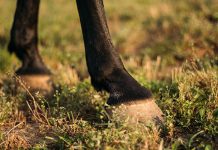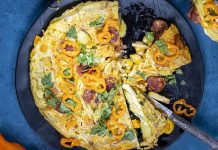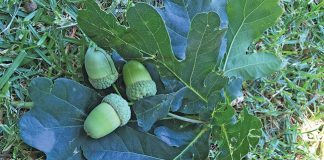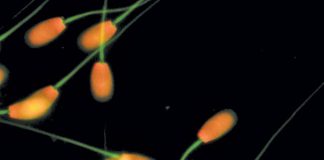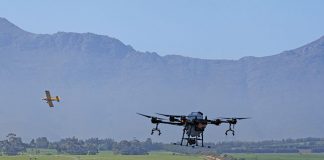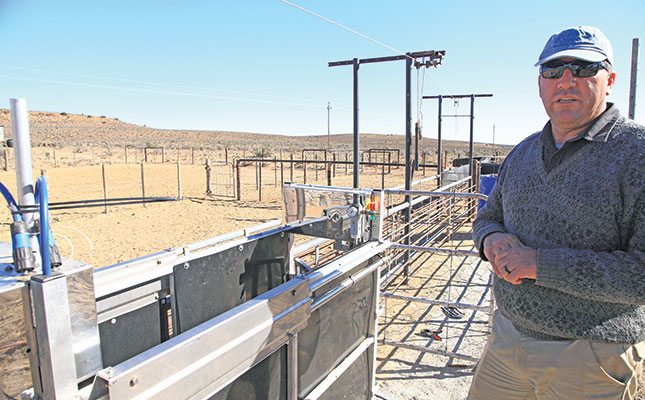
Photo: Wouter Kriel
Hannes Esterhuyse, who runs sheep on the farm Volstruisfontein near Williston in the Northern Cape, says that in order to survive a prolonged drought, simply coping with it is not enough.
“We accepted the drought for what it was and realised we had to work with this new reality. So instead of just waiting for it to break, we decided to be proactive and constantly search for ways to adapt and improve our farming practices.’’
Esterhuyse farms on 22 000ha, part of which he owns and the rest of which he leases. Since 2015, the Williston area in the Karoo has been struggling with prolonged drought, making traditional extensive sheep farming extremely challenging.
“The area has an annual average rainfall of 160mm, most of which ocurs from November to May. In 2015, only 78mm were recorded. Isolated showers brought us luck in 2016 with 188mm, but in 2017 we recorded only 44mm. In 2018, we saw 96mm, in 2019 a total of 61mm, and in 2020 only 139mm.”
To manage this situation, Esterhuyse is applying a three-pronged strategy: better livestock management with the help of technology; diversification; and a commitment to using water as efficiently as possible.
Livestock management
According to Esterhuyse, the terrain of the area is ideal for Dorper sheep. “I love working and interacting with my animals, and the Dorper’s temperament suits me in this regard.”
He had to come to terms with the fact that the drought had reduced carrying capacity.
“We now keep fewer animals, and this means that every ewe and every lamb is important.”
The area is rugged, and tracking and managing the animals is difficult and sometimes not possible under extensive management.
Moreover, with the veld in its present state, it is difficult for a ewe to reach the optimal condition to conceive or produce enough milk to raise a lamb. In addition, because of the drought, many of Esterhuyse’s neighbours have either stopped farming sheep altogether or moved their animals to other areas.
“This means there are more predators focusing on my flock, putting more pressure on our ability to survive,” he says.
“As a result of all this, I moved from extensive-only farming to a balance between extensive and intensive practices. We constructed lambing cages and small camps in the farmyard.”
The ewes lamb in the camps, as this gives Esterhuyse greater control and more management options.
“I won’t keep the animals in the kraal indefinitely, though, as I don’t want the costs of the feed and management that come with it. “The animals have to return to the veld, so we also maintain extensive management practices.
“We’re also implementing precision farming technology, which includes an electronic weighbridge, as well as electronic ear tags linked to a software system, which we’ll integrate with the weighbridge.”
Esterhuyse is currently constructing the weighbridge, which he sees as a management tool to add to his new intensive farming practices.
He explains that for mating purposes, a ewe has to be in a weight-gain phase, or she won’t conceive. Thanks to the weighbridge, he’ll be able to monitor this carefully, adapt the animals’ feeding regimes where needed, and detect health issues early on.
“I’ll also be able to shorten the lambing seasons, which will improve the herd’s uniformity. In a practical sense, this will allow me to put 100 ewes in a camp, weigh them, feed them, and weigh them again two weeks later. Those that have gained weight are ready to mate, and those that haven’t require another management intervention.”
Over the past few years, Esterhuyse has received frequent donations of feed from elsewhere in South Africa.
“I’m very grateful, and as a gesture of my gratitude, I’ve made it my mission to use this feed as productively as possible.
“We’ve also learnt that sometimes the transport costs of a donation make it an unproductive exercise. So we’ve invested in a feed mixer, and this, in combination with the weighbridge, will enable us to manage animal conditioning in a scientific manner.”
The introduction of electronic ear tags enables Esterhuyse to monitor ewes and lambs, as well as maintain an accurate link between the ewes and their respective offspring.
“In the past, we knew when a ewe had lambed, but the question of whether she managed to raise her lamb or lambs had always gone unanswered.
“Moreover, despite knowing that she’d lambed, we didn’t have an accurate record of whether it was a single lamb, twins or triplets.
“It’s no longer good enough to simply ascribe all lamb losses to predators. Since ewes and lambs are now tagged, I have a much deeper level of information at my disposal, and I now know which ewes have strong mothering instincts. It also prevents me from culling a good mother that consistently produces twins, just because she has other challenges that affect her condition.’’
Animal health
Esterhuyse says that while the drought has forced him to cut costs wherever possible, animal health is one area where compromises cannot be made. When the animals are brought to the camp for lambing, they receive a broad-spectrum disease-prevention treatment and antiparasitic medication. This regime is repeated during the mating season, and again when the new lambs’ ears are tagged.
“A sick animal doesn’t process feed optimally,” he explains. “So I’m removing all obstacles to natural growth. It also drastically reduces the possible causes of lamb deaths, which helps me in my response strategies.
“I mark the treated sheep with paint to prevent double treatments, as well as the possibility of a sheep being skipped.”
Esterhuyse says that despite the drought conditions, his aim is to improve his livestock farming every year. “I maintain that a 100% lambing rate is the norm, but my aim is to wean between 120% and 130% by using improved systems and focusing on management.
“At the end of the season, I’ll rework all the numbers to rand/ha to see whether I’m still on track. I believe it’s possible to farm profitably with fewer sheep by improving management practices.”
Adding new crops to the mix
In 2015, Esterhuyse attended an information day on onion seed production and made the decision to diversify his farming business in this direction.
“I visited many farmers and did a lot of research. We have strong boreholes, and although the water is slightly saline, I was convinced through my engagements with other producers that my [farm’s] conditions would be suitable to this crop,’’ he says.
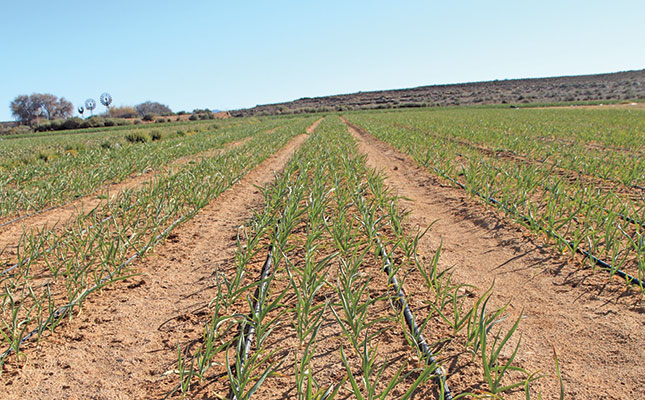
Esterhuyse admits that the potential to generate a large income from a small piece of land attracted him, but he was also aware of the risks involved; he says that farmers need to accept the likelihood of frost, hail and diseases, and these threats need to be managed as part of the package.
“We won onion seed category awards from Klein Karoo Seed Production in 2016 and 2017, and I’m planning to expand my 2,2ha to 6ha, depending on the availability of production contracts.”
Having committed to growing onion seed, the natural progression was to garlic, as they are both part of the same family. Esterhuyse established his first garlic crop in 2020.
“Both crops share growth seasons and have similar nutritional needs. One major advantage for us with garlic is that it is not affected by frost as it grows beneath the soil. It also has a tolerance for high levels of salinity.
“For us, the challenge with garlic lies in marketing the product, and we’re still working on a strategy for doing so optimally,’’ says Esterhuyse.
He adds that because onion production requires the land to be rested for four years after each planting, he has integrated this rotation with his green feed production. There is still some fertiliser and plant food available in the land after the onions, and he utilises this by planting oats afterwards. This becomes a grazing camp for ewes that have produced twins, to give the latter a good start in life. He allows the sheep to graze the oats short, and then uses a planter to establish sorghum as a summer crop in the oats.
“I irrigate the sorghum, and this gives me one more [round of] oat shoots,” he explains.
The value of water
“The drought has given us a deeper appreciation of water,” says Esterhuyse. “I’ve adopted an approach in which no water is wasted, and this informs all farming choices we make. It has influenced the design of the water cribs in the new lambing cages, for example; they’re fitted with ball valves to prevent wastage. In addition, it dictates how we irrigate and grow crops.
“Even though our boreholes are strong, we don’t know what’s going on under the surface, and therefore use the resource as sparingly as possible.”
With the introduction of the onion seed and garlic crops, Esterhuyse has also switched from flood irrigation to a drip system as another means of saving water.
“I can plant more hectares and still use less water than we previously did with crop production,” he says. “Our land straddles the Riet River, and in good years when it flows, we can plant up to 100ha to lucerne.
“We’ve used the drought period to prepare 65ha of land with the assistance of laser technology to create the flattest lands possible. This will allow us to achieve maximum water coverage in the future when it rains and the river runs.”
While the drought has been tough, Esterhuyse says that some good has come of it.
“It pushed me to reconsider my livestock management practices, and investigate alternative crops. It also made me realise the importance of my social network. It’s crucial to have someone to talk to when you’re feeling down. [As farmers], we need to maintain a wider perspective on life outside of our immediate circumstances. This means talking to our family and friends, especially those who are not involved in farming.”
He says that he has also learnt to ask for and accept assistance.
“Our work on the lucerne lands and all the investments we’ve made in the recent past are based on being prepared for when the rain does finally come. This can be very difficult, as our finances are under severe pressure and it’s hard to spend money on something that doesn’t yield a quick return.”
He advises farmers to introduce a strategic partner into their business, “someone who can look past the immediate situation and is willing to invest in the future with you”.
Email Hannes Esterhuyse at [email protected].





